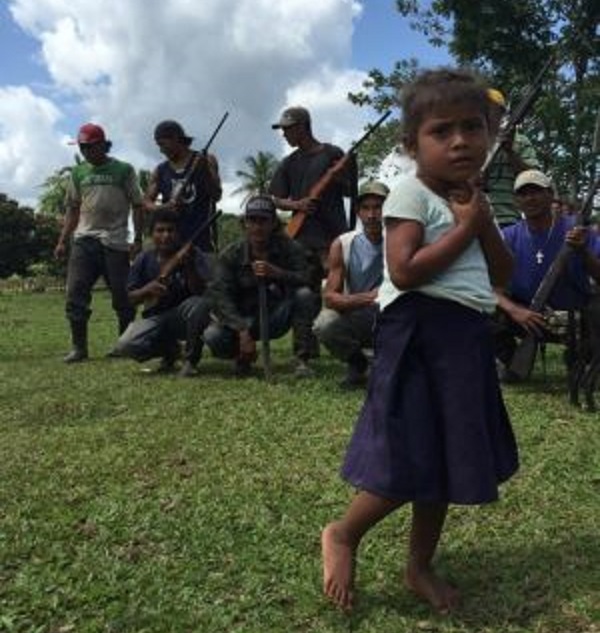
by Deep Green Resistance News Service | Dec 10, 2016 | Colonialism & Conquest
Mayanga family slaughtered by illegal colonizers while planting food on traditional land
Warning: this article includes graphic images that some readers may find disturbing.
by Courtney Parker / Intercontinental Cry
In a shocking escalation of the ongoing violent conflict devastating the Indigenous binational autonomous nation of Moskitia, a Mayanga family of three was killed in a brutal attack by ‘Colonos’ at the Llano Sucio site of the Alamikamba community in the Awala Prinsu territory on November 27, 2016. The attack sent shockwaves through the already war torn territories of Moskitia.
The family’s names and ages were documented by community members; and, the Miskito community continues to seek international solidarity amidst this tragedy and related ongoing devastation. The Mayanga individuals who lost their lives in this most recent and exceptionally brutal attack, have been identified as:
Bernicia Dixon Peralta, age 30 (family and community members claim she was between 3 and 5 months pregnant);

Photo: Cejudhcan Derechos Humanos
Feliciano Benlis Flores, age 37;

Photo: Cejudhcan Derechos Humanos
And, their 11 year old son, Feliciano Benlis Dixon.

Photo: Cejudhcan Derechos Humanos
Reports from the community indicate the family was on the receiving end of threats from invading Colonos – heavily armed Mestizo settlers encroaching on Miskito territory, acting as agents of a large scale land grab. They also say these threats were fully realized last weekend while the family was attempting to plant seeds on their traditional land.
Eklan James Molina, mayor of Alamikamba, which is located in the municipality of Prinzapolka, has demanded a thorough investigation of the massacre. In a statement to one of the few independent news outlets in Nicaragua, La Prensa, he charged: “As mayor, I ask the police and the army to follow up on the case. You have to get to the bottom of why it [occurred].”
In the article published by La Prensa, unverified claims surfaced suggesting the deceased family’s land had been illegally sold to the violent, encroaching settlers by a mysterious third party. Nancy Elizabeth Henriquez, deputy of the YATAMA Indigenous political party – the only real political opposition to the Sandinista state in the region at this time – has dismissed such claims as already having been settled in a court of law; and, explicitly categorized this recent massacre as a revenge killing. In her statement to La Prensa, she relayed, “The owner sued and won the right [to the land] that is theirs; and the Colonos killed the entire family for revenge.” She cited ongoing ethnic clashes as one potential reason the Nicaraguan National Police continue to allow such atrocities to take place with impunity.
Moskitia, a lesser known conflict zone where the violent and heavily armed Meztizo settlers from the Pacific coast and interior of Nicaragua continue to invade traditional and legal Miskito land, has been experiencing escalations in terrorism and violence since June of 2015, according to an official statement issued by the Miskito Council of Elders in August of this year. In a statement published by The Ecologist in October, the elders explained:
“Since ancient times we’ve [cared for] our forests, because apart from being our only means of sustenance, we understand that any alteration to [them] attracts risks; alters our form of life; puts existence itself at risk; causes drastic changes [to] the climate; alters the ecosystem; and breaks our link with our ancestors.
[For] little more than five years, [we] have experienced the largest internal colonization [of] our history. The presence of ‘Colonos’ has drastically altered our form of life. In such a short time [the invasion] has destroyed tens of thousands of hectares of our forests, which has led to [the drying of] our rivers, [causing] the animals [to] migrate and the climate to alter, and us to emigrate. Our large forests are now deserts, occupied for the livestock, and [we] can do nothing to curb the advance of the settlers as they have the support of the Government of Nicaragua and [we] are alone.”
***
At this point, the much hyped November presidential election in Nicaragua has come and gone. President Daniel Ortega managed to further consolidate power and formally establish the foundations for a family dynasty and authoritarian dictatorship. All fanfare aside, Fidel Castro’s recent death means little in a pragmatic sense to the quasi-socialist, former Sandinista revolutionary, Ortega; his contradictory embrace of neoliberalism has carved out even more geopolitical space for a disturbing emerging brand of neoliberal authoritarianism – more in line with Putin’s newly conservative Russia, the theocratic regime of Iran, and the authoritarian capitalism embraced by China, than Fidel’s revolutionary ideals in Cuba. It is thus likely no coincidence that all three of the aforementioned nations have sought a stake in the notorious Nicaragua trans-oceanic canal. After mounting skepticism regarding whether the environmentally catastrophic, human rights disaster would actually come to fruition, recent reports have cited the monstrous development project may be poised to move forward after all. At least 11 non-violent protestors were recently injured amid the growing anti-canal movement.
Another recent report from La Prensa indicates the continued violent expansion of the agricultural frontier into the Indigenous nation of Moskitia – which includes the second largest tropical rainforest in the Western Hemisphere after the Amazon, referred to as the ‘lungs of Mesoamerica’ – may also be tied to Russia’s increasing imperialist presence in the region. A key player in the re-militarization of Nicaragua, Russia recently sold the impoverished nation an estimated 80 million dollars’ worth of military war tanks (some suggesting to suppress ongoing internal dissent) and is launching a strange new imperial drug war in the region. It is unclear what stake Russia has in fighting a drug war in Central America, but the La Presna report suggests that they may be hoping for a payoff in agricultural land appropriated through recent land grabs and ongoing deforestation.
Featured image: A young Miskitu girl stands before an armed indigenous resistance force in Muskitia, Nicaragua. From Ecologist Special Report: The Pillaging of Nicaragua’s Bosawás Biosphere Reserve, by Courtney Parker

by Deep Green Resistance News Service | Dec 1, 2016 | Colonialism & Conquest
Featured image: The Amazon Uncontacted Frontier, a large area on the Peru-Brazil border that is home to the largest concentration of uncontacted tribes in the world. © Survival International
By Survival International
A new “death road” advocated by a notorious Italian priest is set to cut in two the land of several uncontacted tribes in the heartland of the Amazon Uncontacted Frontier.
The road is expected to be approved by Peru’s congress soon, and will run through 270 km of the Amazon’s most biodiverse and sensitive protected areas.
The project has been supported for years by Father Miguel Piovesan, a Catholic priest who has described the local tribal peoples as “prehistoric,” and slammed international NGOs for raising concerns about the plan.
The road was rejected by Peru’s Congress in 2012. Despite this, work continued illegally for many years, and now the project has been proposed again by Congressman Carlos Tubino.
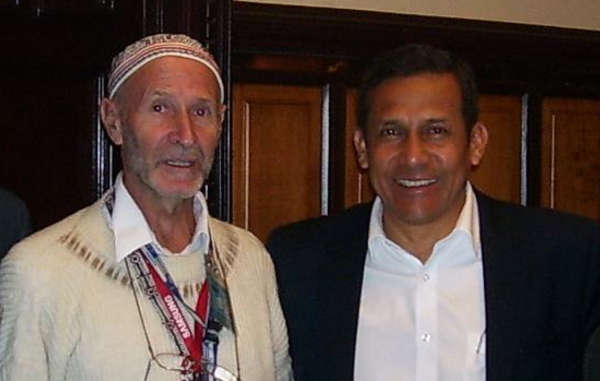
Fr. Miguel Piovesan, the main backer of the Purus road, alongside former President Ollanta Humala.
© Anon
Uncontacted tribes are the most vulnerable peoples on the planet. There are estimated to be around 15 uncontacted peoples in Peru, many of them in the region where the road will be built.
Survival International has lodged a complaint with the United Nations, citing the catastrophic impact on the uncontacted Indians and urging the Peruvian government to veto the plan.
Of the 3-4,000 people in the area, around 80% are indigenous. Most of them are opposed to the road.
Emilio Montes, president of the indigenous organization FECONAPU, which is based in Puerto Esperanza said: “We flatly reject this road. We indigenous people won’t benefit from it, only the loggers, miners, oil companies and narcotraffickers. It threatens the lives of our isolated relatives, like the Mashco Piro. It will destroy our animals and plants. They should, instead, respect our ancestral territories. We’ve always lived here, and our children must carry on doing so. We need another type of development which looks after our resources sustainably: so that we can live properly, and secure our future.”
Survival’s Director Stephen Corry said: “If this road goes ahead, it will destroy the uncontacted tribes, and their “development” will be terminated for ever. Survival has fought roads in this part of Amazonia for decades. Who are they supposed to help? If Peru has any respect for fundamental human rights and the rule of law, it must stop these plans now.”
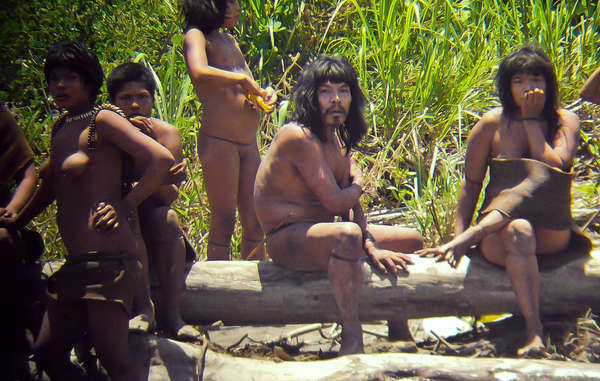
Uncontacted Mashco-Piro Indians on a riverbank near the Manú National Park. 2011.
© Jean-Paul Van Belle
Background
- The road will connect Puerto Esperanza to the Inter-Oceanic Highway, which runs through Peru and Brazil. The area is part of the Amazon Uncontacted Frontier, the region along the Peru-Brazil border with the highest concentration of uncontacted tribes in the world.
- Uncontacted peoples who could be wiped out if the road is built include the Mashco Piro, Chitonahua, Mastanahua and Sapanawa, who have all lived nomadically in the region for generations. Outsiders such as missionaries and loggers have forced several groups to make contact in recent years.
- Elsewhere in the Amazon, road “development” projects have allowed an influx of colonists to access remote areas and threaten the lives and lands of uncontacted peoples.
- Several indigenous organizations in Peru have made a statement rejecting the road.
- Fr. Piovesan has repeatedly denied the existence of uncontacted peoples. His parish newsletter stated that: “Isolation is not a natural wish. We can’t prove that isolated people exist. They are dreamt up by those who barely know indigenous people, or base their investigations on unproven theories.”
- Uncontacted Indians have clearly expressed their desire to remain uncontacted. The project cannot be carried out with their consent and will violate their right to determine their own futures.
We know very little about uncontacted tribes. But we do know there are more than a hundred around the world. And we know whole populations are being wiped out by genocidal violence from outsiders who steal their land and resources, and by diseases like flu and measles to which they have no resistance.
Uncontacted tribes are not backward and primitive relics of a remote past. They are our contemporaries and a vitally important part of humankind’s diversity. Where their rights are respected, they continue to thrive.
All uncontacted tribal peoples face catastrophe unless their land is protected. Survival International are doing everything we can to secure their land for them, and to give them the chance to determine their own futures.
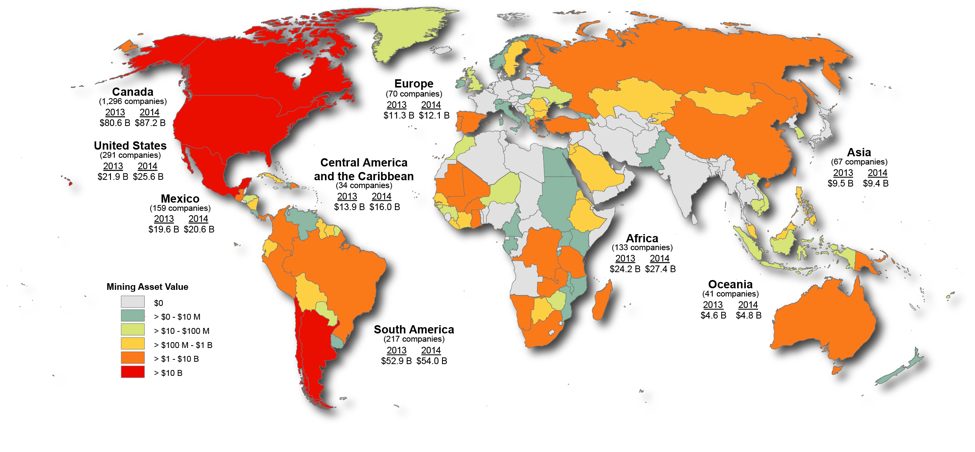
by Deep Green Resistance News Service | Nov 17, 2016 | Colonialism & Conquest, Mining & Drilling
by Jen Moore / Canadian Centre for Policy Alternatives
Stories of bloody, degrading violence associated with Canadian mining operations abroad sporadically land on Canadian news pages. HudBay Minerals, Goldcorp, Barrick Gold, Nevsun and Tahoe Resources are some of the bigger corporate names associated with this activity. Sometimes our attention is held for a moment, sometimes at a stretch. It usually depends on what solidarity networks and under-resourced support groups can sustain in their attempts to raise the issues and amplify the voices of those affected by one of Canada’s most globalized industries. But even they only tell us part of the story, as Todd Gordon and Jeffery Webber make painfully clear in their new book, The Blood of Extraction: Canadian Imperialism in Latin America (Fernwood Publishing, November 2016).
“Rather than a series of isolated incidents carried out by a few bad apples,” they write, “the extraordinary violence and social injustice accompanying the activities of Canadian capital in Latin America are systemic features of Canadian imperialism in the twenty-first century.” While not completely focused on mining, The Blood of Extraction examines a considerable range of mining conflicts in Central America and the northern Andes. Together with a careful review of government documents obtained under access to information requests, Gorden and Webber manage to provide a clear account of Canadian foreign policy at work to “ensure the expansion and protection of Canadian capital at the expense of local populations.”
Fortunately, the book is careful, as it must be in a region rich with creative community resistance and social movement organizing, not to present people as mere victims. Rather, by providing important context to the political economy in each country studied, and illustrating the truly vigorous social organization that this destructive development model has awoken, the authors are able to demonstrate the “dialectic of expansion and resistance.” With care, they also show how Canadian tactics become differentiated to capitalize on relations with governing regimes considered friendly to Canadian interests or to try to contain changes taking place in countries where the model of “militarized neoliberalism” is in dispute.
The spectacular expansion of “Canadian interests” in Latin America
We are frequently told Canadian mining investment is necessary to improve living standards in other countries. Gordon and Webber take a moment to spell out which “Canadian interests” are really at stake in Latin America—the principal region for Canadian direct investment abroad (CDIA) in the mining sector—and what it has looked like for at least two decades: “liberalization of capital flows, the rewriting of natural resource and financial sector rules, the privatization of public assets, and so on.”
Cumulative CDIA in the region jumped from $2.58 billion in stock in 1990 to $59.4 billion in 2013. These numbers are considerably underestimated, the authors note, since they do not include Canadian capital routed through tax havens. In comparison, U.S. direct investment in the region increased proportionately about a quarter as much over the same period. Despite having an economy one-tenth the size of the U.S., Canadian investment in Latin America and the Caribbean is about a quarter the value of U.S. investment, and most of it is in mining and banking.
Canadian mining investment abroad
To cite a few of the statistics from Gordon and Webber’s book, Latin America and the Caribbean now account for over half of Canadian mining assets abroad (worth $72.4 billion in 2014). Whereas Canadian companies operated two mines in the region in 1990, as of 2012 there were 80, with 48 more in stages of advanced development. In 2014, Northern Miner claimed that 62% of all producing mines in the region were owned by a company headquartered in Canada. This does not take into consideration that 90% of the mining companies listed on Canadian stock exchanges do not actually operate any mine, but rather focus their efforts on speculating on possible mineral finds. This means that, even if a mine is eventually controlled by another source of private capital, Canadian companies are very frequently the first face a community will see in the early stages of a mining project.
The results have been phenomenal “super-profits” for private companies like Barrick Gold, Goldcorp and Yamana, who netted a combined $2.8-billion windfall in 2012 from their operating mines, according to the authors. (Canadian mining companies earned a total of $19.3 billion that year.) Between 1998 and 2013, the authors calculate that these three companies averaged a 45% rate of profit on their operating mines when the Canadian economy’s average rate of profit was 11.8%.
Compare this to Canada’s miserly Latin American development aid expenditures of $187.7 million in in 2012—a good portion of this destined for training, infrastructure and legislative reform programs intended to support the Canadian mining sector. Or consider that the same year $2.8 billion was taken out of Latin America by three Canadian mining firms, remittances back to the region from migrants living in Canada totalled only $798 million (much more than Canadian aid).
Without spelling out the long-term social and environmental costs of these operations—costs that are externalized onto affected communities—or going into the problematic ways that private investment and Canadian aid can be used to condition local support for a mine project, Gordon and Webber posit that “super-profits” may be precisely the “Canadian interests” the government’s foreign policy apparatus is set up to defend—not authentic community development, lasting quality jobs or a reliable macroeconomic model.
State support for “militarized neoliberalism”
The argument that the role of the Canadian state is “to create the best possible conditions for the accumulation of profit” is central to Gordon and Webber’s book. From the Prime Minister’s Office (PMO) down, Canadian agencies and foreign policy have been harnessed to justify “Canadian plunder of the wealth and resources of poorer and weaker countries.” Furthermore, they write, Canada has actively supported the advancement of “militarized neoliberalism” in the region, as country after country has returned to extractive industry, and export-driven and commodity-fuelled economic growth, which comes with high costs for affected-communities and other macroeconomic risks:
The extractive model of capitalism maturing in the Latin American context today does not only involve the imposition of a logic of accumulation by dispossession, pollution of the environment, reassertion of power of the region by multinational capital, and new forms of dependency. It also, necessarily and systematically involved what we call militarized neoliberalism: violence, fraud, corruption, and authoritarian practices on the part of militaries and security forces. In Latin America, this has involved murder, death threats, assaults and arbitrary detention against opponents of resource extraction.
The rapid and widespread granting of mining concessions across large swaths of territory (20% of landmass in some countries), regardless of who lives there or how they might value different lands, water or territory, has provoked hundreds of conflicts and powerful resistance from the community level upward. In reaction, and in order to guarantee foreign investment, in many parts of the region states have intensified the demonization and criminalization of land- and environment-defenders, while state armed forces have increased their powers, and para-state armed forces expanded their territorial control.
Far from being a countervailing force to this trend, the Canadian state has focused its aid, trade and diplomacy on those countries most aligned with its economic interests. It is not unusual to see public gestures of friendship or allegiance toward governments “that share [Canada’s] flexible attitude towards the protection of human rights,” such as Mexico, post-coup Honduras, Guatemala and Colombia. Meanwhile, Canada has used diverse tactics (in Venezuela and Ecuador, for example) to contain resistance and influence even modest reforms.
Canada’s ‘whole-of-government’ approach in Honduras
One of the more detailed examples in Blood of Extraction of Canadian imperialism in Central America covers Canada’s role in Honduras following the military-backed coup in June 2009. Documents obtained from access to information requests provide new revelations and new clarity into how Canadian authorities tried to take advantage of the political opportunities afforded by the coup to push forward measures that favour big business. Once again, though other economic sectors are discussed, mining takes centre stage.
After the terrible experience of affected communities with Goldcorp’s San Martin mine (from the year 2000 onward), Hondurans successfully put a moratorium on all new mining permits pending legal reforms promised by former president José Manuel Zelaya. On the eve of the 2009 coup, a legislative proposal was awaiting debate that would have banned open-pit mining and the use of certain toxic substances in mineral processing, while also making community consent binding on whether or not mining could take place at all. The debate never happened.
Instead, shortly after the coup, and once a president more friendly to “Canadian interests” was in place following a questionable election, the Canadian lobby for a new mining law went into high gear. A key goal for the Canadian government, according to an embassy memo, was “[to facilitate] private sector discussions with the new government in order to promote a comprehensive mining code to give clarity and certainty to our investments.” Another embassy record said that mining executives were happy to assist with the writing of a new mining law that would be “comparable to what is working in other jurisdictions” and developed with a resource person with whom their “ideologies aligned.”
In a highly authoritarian and repressive context, and under the deceptive banner of corporate social responsibility, the Canadian Embassy—with support from Canadian ministerial visits, a Honduran delegation to the annual meeting of the Prospectors & Developers Association of Canada (PDAC), and overseas development aid to pay for technical support—managed to get the desired law passed in early 2013, lifting the moratorium. Then, in June 2014, with full support from Liberals and Conservatives in the House of Commons and the Senate, Canada ratified a free trade agreement with Honduras, effectively declaring that “Honduras, despite its political problems, is a legitimate destination for foreign capital,” write Gordon and Webber.
Contrary to the prevailing theory in Canada that sustaining and increasing economic and political engagement with such a country will lead to improved human rights, the social and economic indicators in Honduras have gotten worse. Since 2010, the authors note, Honduras has the worst income distribution of any country in Latin America (it is the most unequal region in the world). Poverty and extreme poverty rates are up by 13.2% and 26.3%, respectively, after having fallen under Zelaya by 7.7% and 20.9%. Compounding this, Honduras is now the deadliest place to fight for Indigenous autonomy, land, the environment, the rule of law, or just about any other social good.
A strategy of containment in Correa’s Ecuador
In contrast to how Canada has more strongly aligned itself with Latin American regimes openly supportive of militarized neoliberalism, the experience in Ecuador under the administration of President Rafael Correa illustrates how Canada considers “any government that does not conform to the norms of neoliberal policy, and which stretches, however modestly, the narrow structures of liberal democracy…a threat to democracy as such.”
In the chapter on Ecuador, Gordon and Webber provide a detailed account of Canada’s “whole-of-government” approach to containing modest reforms advanced by Correa and undermining the opposition of affected communities and social movements to opening the country to large-scale mining. A critical moment in this process occurred in mid-2008, when a constitutional-level decree was issued in response to local and national mobilizations against mining. The Mining Mandate would have extinguished most or all of the mining concessions that had been granted in the country without prior consultation with affected communities, or that overlapped with water supplies or protected areas, among other criteria. It also set in place a short timeline for the development of a new mining law.
The Canadian embassy immediately went to work. Meetings between Canadian industry and Ecuadorian officials, including the president, were set up to ensure a privileged seat at talks over the new mining law. Gordon and Webber’s review of documents obtained under access to information requests further reveals that the embassy even helped organize pro-mining demonstrations together with industry and the Ecuadorian government. Embassy records describe their intention “to create sympathy and support from the people” as part of a “a pro-image campaign,” which included “an aggressive advertisement campaign, in favour of the development of mining in Ecuador.” Meanwhile, behind closed doors, industry threatened to bring international arbitration against Ecuador under a Canada–Ecuador investor protection agreement (which a couple of investors eventually did).
Ultimately, the authors conclude, Canadian diplomacy “played no small part” in ensuring that the Mining Mandate was never applied to most Canadian-owned projects, and that a relatively acceptable new mining law was passed in early 2009. While embassy documents show the Canadian government considered the law useful enough to “open the sector to commercial mining,” it was still not business-friendly enough, particularly because of the higher rents the state hoped to reap from the sector. As a result, the embassy kept up the pressure, including using the threat of withholding badly needed funds for infrastructure projects until mining company concerns were addressed and dialogue opened up with all Canadian companies.
Not discussed in The Blood of Extraction, we also know the pressure from Canadian industry continued for many more years, eventually achieving reforms, in 2013, that weakened environmental requirements and the tax and royalty regime in Ecuador. Meanwhile, as the door opened to the mining industry, mining-affected communities and supporting organizations were feeling the walls of political and social organizing space cave in, as they faced persistent legal persecution and demonization from the state itself, while the serious negative impacts of the country’s first open-pit copper mine started to be felt.
Canada’s “cruel hypocrisy”
The Blood of Extraction is a helpful portrait of “the drivers behind Canadian foreign policy.” Gordon and Webber lay bear “a systematic, predictable, and repeated pattern of behaviour on the part of Canadian capital and the Canadian state in the region,” along with its systemic and almost predictable harms to the lives, wellbeing and desired futures of Indigenous peoples, communities and even whole populations. They call it Canada’s “cruel hypocrisy.”
The problem is not Goldcorp or HudBay Minerals, Tahoe Resources or Nevsun. These companies are all symptoms of a system on overdrive, fuelling the overexploitation of land, communities, workers and nature to fill the pockets of a small transnational elite based principally in the Global North. If we cannot see how deeply enmeshed Canadian capital is with the Canadian state—how “Canadian interests” are considered met when Canadian-based companies are making super-profits, even through violent destruction—we cannot get a sense of how thoroughly things need to change.
Jen Moore is the Latin America Program Coordinator at Mining Watch Canada, working to support communities, organizations and networks in the region struggling with mining conflicts.
This article was published in the November/December 2016 issue of The Monitor. Click here for more or to download the whole issue.
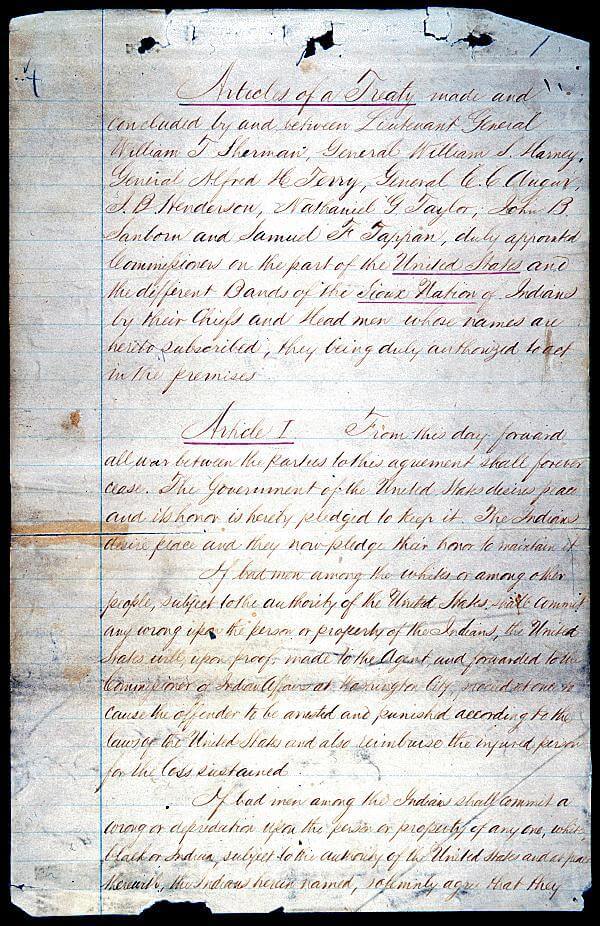
by Deep Green Resistance News Service | Nov 15, 2016 | Colonialism & Conquest
If treaties are the supreme law of the land, as the U.S. Constitution states, then how is it that treaties can be so easily broken by a government that claims to uphold a respect for the law? An even more unsettling question: how is it that the trail of broken treaties has been able to span generations under an outdated, imperial logic unknown to the majority of the U.S. citizens? The founding of the United States is predicated on this painful contradiction between principles of equality and rule of law on one side, and the colonial appropriation of land from native peoples who have inhabited them for millennia, on the other.
The current resistance against the construction of the Dakota Access Pipeline (DAPL) is inscribed in this contradiction, making evident the non-rule of law when it comes to appropriating native lands.
The history of Standing Rock is marked by the history of colonization predicated on the Doctrine of Discovery. The progressive erosion of its Sioux territory goes hand in hand with the logic of terra nullius, which framed land in the Americas as “empty” in order to justify settler colonization.
The Sioux Nation has historically engaged in sovereign government-to-government relations with the US government. The first treaty in which the two parties engaged as diplomatic equals was the Treaty of Fort Laramie of 1851. It was the U.S. government who sought the treaty to allow for safe passage of the influx of settlers travelling west through Sioux territory during the Gold Rush from the east coast to California.
The process of negotiating the Treaty of Fort Laramie followed the colonial settler standard used in contemporary treaty negotiations. While the process was equal in theory to the traditional communal decision-making processes under which many Native Nations operated, the colonial method, which uses elected representatives, heavily favored the interests of the colonial government. Ultimately, the treaty established distinct territories for just under 10 Great Plain tribes. The treaty also permitted settlers to travel on the Platte River Road, achieving the U.S. government’s goal.
The 1851 treaty defined Sioux territory as the land where the DAPL is now being constructed. The territory fell within the western half of modern South Dakota, northwest Nebraska, a portion of northeast Wyoming, and a small part of southeast Montana and southwest North Dakota.
From the very beginning, various parties continuously broke the Treaty of Fort Laramie. Many tribes, unaware of the existence of the treaty, continued to carry out raids on tribes on legally different territories. Furthermore, settlers increasingly trespassed into the treaty territories, disrupting the buffalo hunting grounds of Native Nations. The settlers’ wrongful presence on native land led to various hostile skirmishes and bloody battles in which natives were massacred often without provocation.
But the violation of the Treaty of Fort Laramie didn’t stop there. Over the years, the U.S. government has continued to appropriate Sioux land in an ongoing process of colonization that disregards the treaty. (See map.)
In 1861, the discovery of gold in present-day Montana accentuated the flood of fortune-seekers overrunning Sioux lands in violation of the decade-old Laramie Treaty. Sioux protests to defend their rights and territory were ignored, so the Sioux took matters into their own hands to stop the trespassers. The U.S. responded by sending in a military presence.
Instead of adhering to the terms of the treaty, the U.S. government attempted to negotiate another treaty more preferential to its interests. Treaty making, instead of a diplomatic engagement between two equally powerful sovereign nations had turned into a destructive means of grabbing land and resources from native people; a form of “conquest by law” as per the book by Lindsay G. Robertson.
The result was a second treaty of Fort Laramie signed in 1868. This new treaty shrank the territorial boundaries of the Great Sioux Reservation in exchange for the U.S. federal government’s removal of all existing forts in the Powder River area, among other specifications. Yet it was a flawed treaty from the start. Most importantly, it stipulates that no changes can be made to the legally binding agreement unless ¾ of all adult Sioux males consent. Many members of the Sioux nation, particularly those within the boundaries of the territory signed the treaty. But many more bands residing north of the Bozeman Trail, such as the Hunkpapa and Sihasapa bands, did not. The treaty was not signed by three quarters of all adult Sioux males.
Yet, again, the U.S. government violated the treaty. The second Laramie treaty granted the tribes the right of regulating the entry of persons into their territory. Article II of the 1868 Treaty stipulates that nobody can enter the territory without tribal permission. But time and time again settlers have encroached on Sioux territory.
Some Americans may know that in 1874 the U.S. government sent George Custer with a group of scientists to search for natural resources, especially gold, in the isolated mountain range known today as the Black Hills. The gold they found led to an influx of miners, again in direct violation of the treaty.
Eventually, the U.S. government decided to pursue its strategy of land appropriation without bothering with the pretense of legality. The Sioux learned to be wary of treaties with the U.S. and refused to sign away their land.
In 1877, Congress unilaterally passed an act removing the sacred Black Hills from the Great Sioux Reservation, without the ¾ consent of the Sioux mandated by the Laramie Treaty of 1868. This illegal grab of sacred land brought no legal repercussions to the party that violated the treaty—the U.S. government.
In 1889, Congress again diminished the Great Sioux Reservation with the Dawes Act and Allotment Act, partitioning it into six sections, one of which was the Standing Rock Sioux Reservation. This opened up parts of the reservation to outside settlement, even though the native government still controls all reservation lands.
Sioux struggles for water are embedded in such displacements. In 1948, the U.S. government began construction of Oahe Dam, despite resistance from local tribes. Its creation flooded tribal land and forced a quarter of the reservation’s inhabitants to move.
In 1958, a federal court ruled that Lake Oahe was part of the Standing Rock territory according to the 1868 Fort Laramie Treaty. In this ruling the court said, “Where there is a treaty with Indians which would otherwise restrict the Congress, Congress can abrogate the treaty in order to exercise its sovereign right.” The court openly articulated the self-arrogated right of the U.S. government to go back on treaty obligations with Native Americans to unilaterally exercise its sovereign power.
The U.S. did just that, taking the Lake Oahe land from the Standing Rock tribe through legislation passed by Congress in September 1958 [Public Law 85-915].
Legal abrogation, or repealing legislation, dispenses with any idea of fair treaty making between equals. It undermines native sovereignty, following a racist logic of colonial elimination. It dispenses with numerous prior legal precedents that granted Native Americans some rights, such as the Indian Appropriations Act of 1871, which declared that no treaty obligation with an Indian nation before March 3, 1871 can be “invalidated or impaired.” It puts into question the idea of the “federal Indian trust responsibility,” articulated in the Seminole Nation v. United States case of 1942, which entailed an obligation on the part of the U.S. government to protect tribal treaty rights, land, assets and resources, per the Department of the Interior Indian Affairs branch.
As a federally recognized tribe, the Standing Rock Sioux Tribe is legally entitled to these obligations. However, as history has shown, U.S. principles and laws do not seem to have the same meaning when it comes to Native Americans.
The United States claim that it can abrogate treaties with Native Americans has been upheld by US courts as legal. Law in our modern eyes carries the weight of legitimacy.
But because something is legal does not make it right. In the case of the Sioux, alongside every other Native American nation, laws and treaties have all too often been used not as a protective shield, or even as a neutral arbitrator, but as a weapon. That weapon is predicated on a racist, colonial history that invalidated native people’s rights to their land, to their sovereignty, to their cultural expression, to their very lives.
Whether it is the gold rush or the oil rush, the U.S government continues even now to invade native land and break treaties. The proposed DAPL would pass under Lake Oahe, the land that was openly, “legally” taken from the Sioux tribe in 1958 by Congress, despite the prior 1868 Treaty that had legally granted the Sioux rights to the land.
Today’s protests at Standing Rock today can only be fully understood in light of this colonial legacy, which from the beginning proclaimed that native lands were empty and that native people, were, in effect, nothing more than the rocks, the trees, the water that they now so valiantly strive to protect.
Let us fight against this narrative, and show through Standing Rock that native tribes are sovereign nations that possess the inherent right to life on their territories. Let us show that Native American lands are not empty, but that proud sovereign peoples live there, alongside the earth, water, rocks and trees, wind and sky, encompassing a vibrant fullness in their long defense of life.
There never was terra nullius. The only emptiness to be found exists in the hollow promises of the United States, in the historic lack of equitable substance in the U.S. legal system.
In that spirit, many U.S. citizens are now, finally, refusing to turn a blind eye to the trail of broken treaties. They stand with Standing Rock, and are petitioning President Obama to honor the treaties (petition here): “The Native nations have upheld their end of the bargain; it is time the U.S. government did the same.”

by Deep Green Resistance News Service | Nov 2, 2016 | Biodiversity & Habitat Destruction, Colonialism & Conquest
Featured image: World Wildlife Fund trustee Peter Flack with dead forest elephant. © Survival International
by Survival International
Survival International has learned that an elephant-hunting safari operation jointly owned by a French billionaire has been implicated in human rights abuses against local Baka “Pygmies” and their neighbors, including illegal evictions and torture.
The operation is based in two “protected areas” in Cameroon, leased by Benjamin de Rothschild. It offers tourists the chance to pay €55,000 to shoot a forest elephant.
Baka were evicted from their ancestral land to create the trophy hunting operation, contrary to international law. It is patrolled by soldiers, police and armed guards, and Baka have now been told they will be shot on sight if they cross it to hunt to feed their families, gather plants, or visit religious sites.
The Baka report that three of their forest camps have been burnt by wildlife guards and safari camp employees in the last year alone. Baka men hunting for food in this forest have been beaten by local police, soldiers and wildlife guards.

Benjamin de Rothschild, joint owner of a luxury elephant-hunting operation on Baka land
© JeuneAfrique
One Baka man told Survival: ”They told me to carry my father on my back. I started walking, [the guard] beat me, he beat my father. For three hours, every time I cried out they would beat me, until I fainted and fell to the ground with my father.”
Another Baka man said: “When the trophy-hunting company finds us here they burn the camps. They beat us, they search for us, they set their dogs on you, their guns on you.”
A third Baka said: “The trophy-hunting company said that if they see anyone [in the forest] bullets will fly. Now those who have family there have gone to get them out. How will we live now?”
Survival contacted Mr. de Rothschild informing him of reports of serious human rights abuses having been committed to maintain the trophy-hunting operation, but has received no reply.
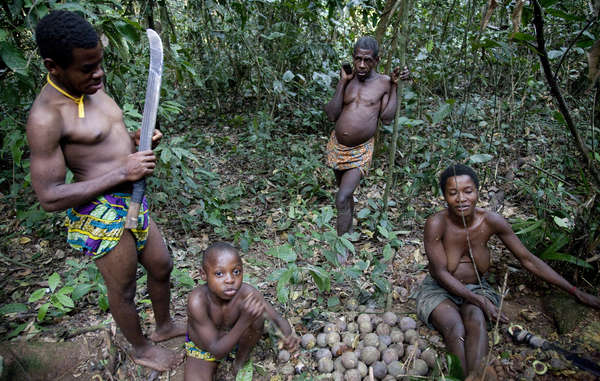
The Worldwide Fund for Nature (WWF) is very active in Cameroon, and the trophy-hunting “protected areas” form part of one of their key “conservation landscapes.” WWF has yet to comment on the allegations, or say whether it proposes to take any action.
One booking operator told Survival that: “All our luxurious fully equipped forest camps are solid construction, air conditioned with private chalets with full bathrooms and dressing parlors. Delicious multi-course cuisine is served with top shelf European wines and beverages… Our newest forest camp has a large screened in swimming pool.”
Watch: Baka plead for forest guards to leave them in peace.
© Survival International
Across the region, Baka “Pygmies” and their neighbors are being evicted from their ancestral homelands and face arrest and beatings, torture and even death while big game trophy-hunting is encouraged. WWF trustee Peter Flack has also hunted elephants in the region.
Survival’s Director Stephen Corry said: “Across Africa, rich trophy hunters are welcomed into the same areas where tribal hunters are illegally evicted from their ancestral homelands and brutalized for hunting to feed their families. This has to stop. Conservation in the Congo Basin is land theft, a continuation of colonialism. It leads to widespread and horrific human rights violations, including extrajudicial killing. Why are so few people speaking out? Survival is leading the fight against these abuses. Conservationists must respect human rights like everyone else is supposed to.”
Click here to find out more and take action.
This is not an isolated incident. Across Africa, tribal people are accused of “poaching” because they hunt to feed their families. And they face arrest and beatings, torture and death, while big game trophy hunters are encouraged. Survival International is leading the fight against these abuses.
Note: “Pygmy” is an umbrella term commonly used to refer to the hunter-gatherer peoples of the Congo Basin and elsewhere in Central Africa. The word is considered pejorative and avoided by some tribespeople, but used by others as a convenient and easily recognized way of describing themselves.
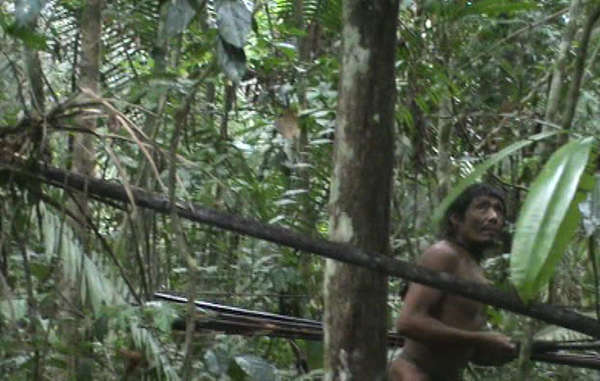
by Deep Green Resistance News Service | Oct 28, 2016 | Colonialism & Conquest
by Survival International
Waves of loggers are invading the territory of one of the most vulnerable peoples on the planet. The Indians, known as the Last of the Kawahiva, are the survivors of a larger tribe who have been killed or died of disease.
One group of loggers was recently caught by agents from FUNAI, Brazil’s Indigenous Affairs department. However, as the loggers have local political support, and FUNAI agents do not have the power to arrest suspects, the men were released. Further waves of loggers have since entered the territory.
The crisis has raised concerns among campaigners that the tribe and their rainforest home could be destroyed entirely.
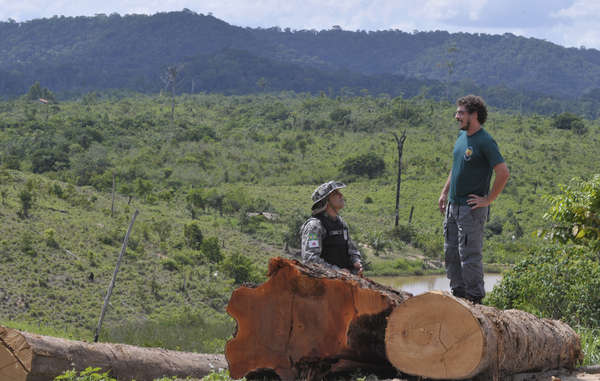
FUNAI agents work in many parts of Brazil to protect indigenous territories from loggers and other threats. © Mário Vilela/FUNAI
In April 2016, the Brazilian Minister of Justice signed a decree to create a protected indigenous territory on the tribe’s land to keep loggers and other intruders out. This was a big step forward for the Kawahiva’s lands and lives, and followed pressure from Survival’s supporters around the world. However, the decree has yet to be properly enacted and now the small team who are working to protect the land are facing severe budget cuts.
Jair Candor, an experienced FUNAI agent, said: ”The Kawahiva are trapped. If any contact happens, it will be devastating for them. The only way to ensure their survival is to map out the land and put in place a permanent land protection team. Otherwise, they will be relegated to the history books, just like so many other tribal peoples of this region.”
Oscar-winning actor Mark Rylance has narrated a film to highlight the tribe’s plight.
Survival’s Director Stephen Corry said: “Brazil committed to protecting the Kawahiva’s land in April, but with the government dragging its heels an urgent and horrific humanitarian crisis is unfolding. The Kawahiva’s land is still being invaded and their forest is still being destroyed. It’s time for Brazil to take action as it promised, before the genocide of an entire people is complete.”














